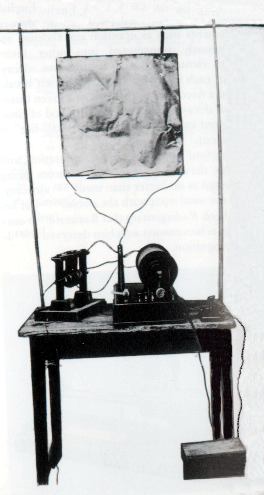
| LECTURE DEMONSTRATION MANUAL | Instructional Research Lab : ucla physics | |
| main page | Hertzian Waves |
| table of contents | |
| search | |
|
E.5.8 Hertzian Waves A small vacuum tube transmitter feeds an electric dipole antenna. The EM waves with l = 3m are picked up by a handheld dipole receiving antenna and detected by a peanut light bulb. Several aspects of dipole radiation can be illustrated with this setup:
E.5.8b Modern Version of Hertz Wave Experiment A VCR is set up with a videotape broadcasting on Ch 3. Instead of wiring the cable directly to the TV, it goes instead to a folded dipole antenna optimized for the frequency of Ch 3, which is 60 66 MHz. The receiver is a second folded dipole antenna which is connected to the TV (tuned to Ch 3), which acts as the detector. It is easy to diplay the polarization of the EM waves by turning one of the dipole antennas at a right angle to the other. If there are standing waves in the room these can be seen by moving one antenna in relation to the other. From the distance between nodes the wavelength can be determined. TV stations have a 6 MHz bandwidth. Channel 3 is 60 66 MHz which gives a wavelength of 5 meters. How are TV antenna oriented on a roof? That gives the polarization. FM frequencies are 88 108 MHz Broadcast antenna are horizontal or 45o AM 550 1600 kHz Vertically polarized antenna, usually center-fed dipole with image in ground. Cellular phone antenna are usually ¼ wavelength. From the antenna size you can guess the frequency. The antenna used in this demo are folded dipole type made from 300 Ohm twin lead. They are connected to 75 Ohm cable through impedance transformers. To see how the radio spectrum is divided up by users press here. |
|
A radio transmitting apparatus used by Marconi in 1895 in some of his earliest experiments. |